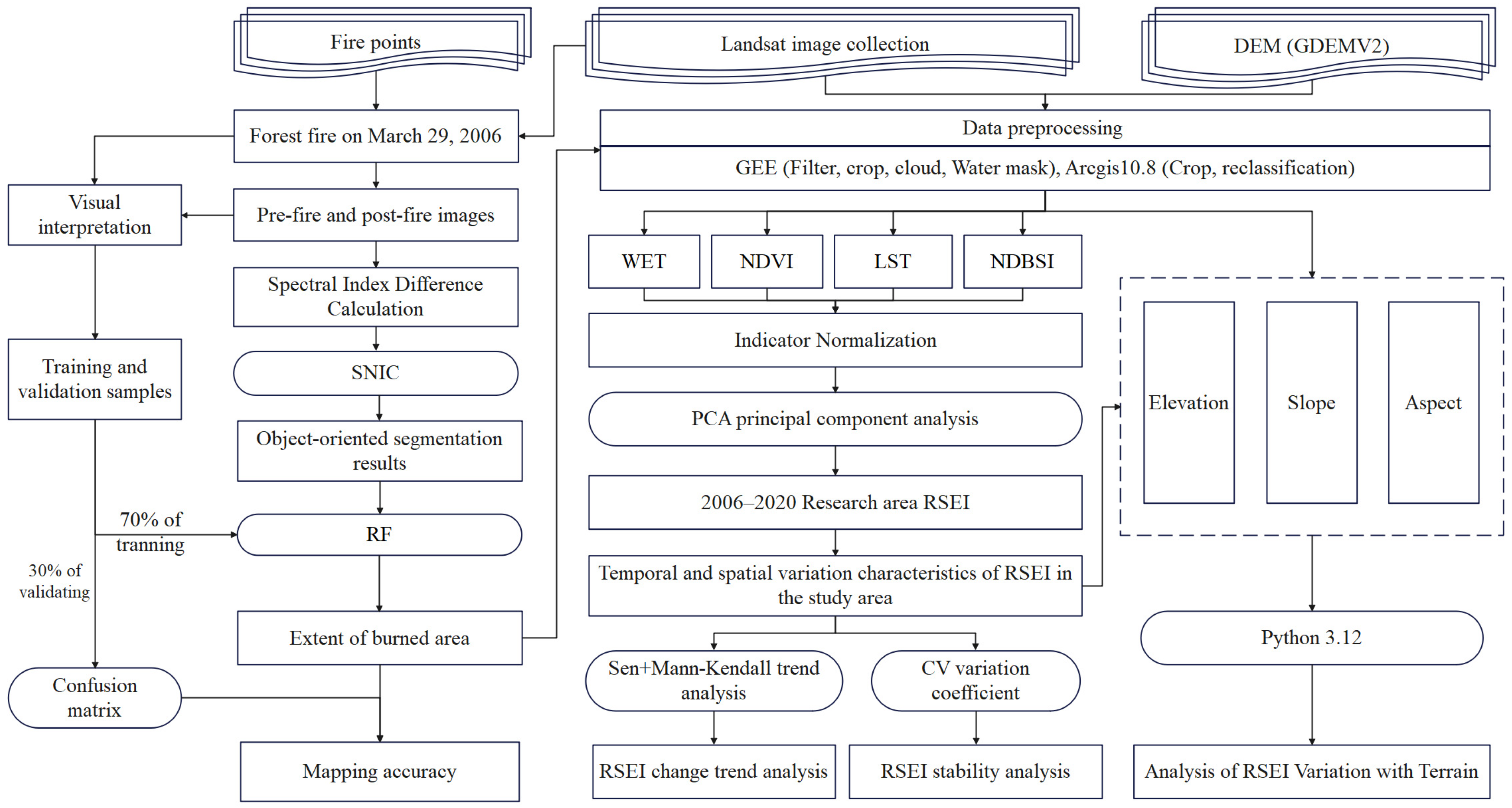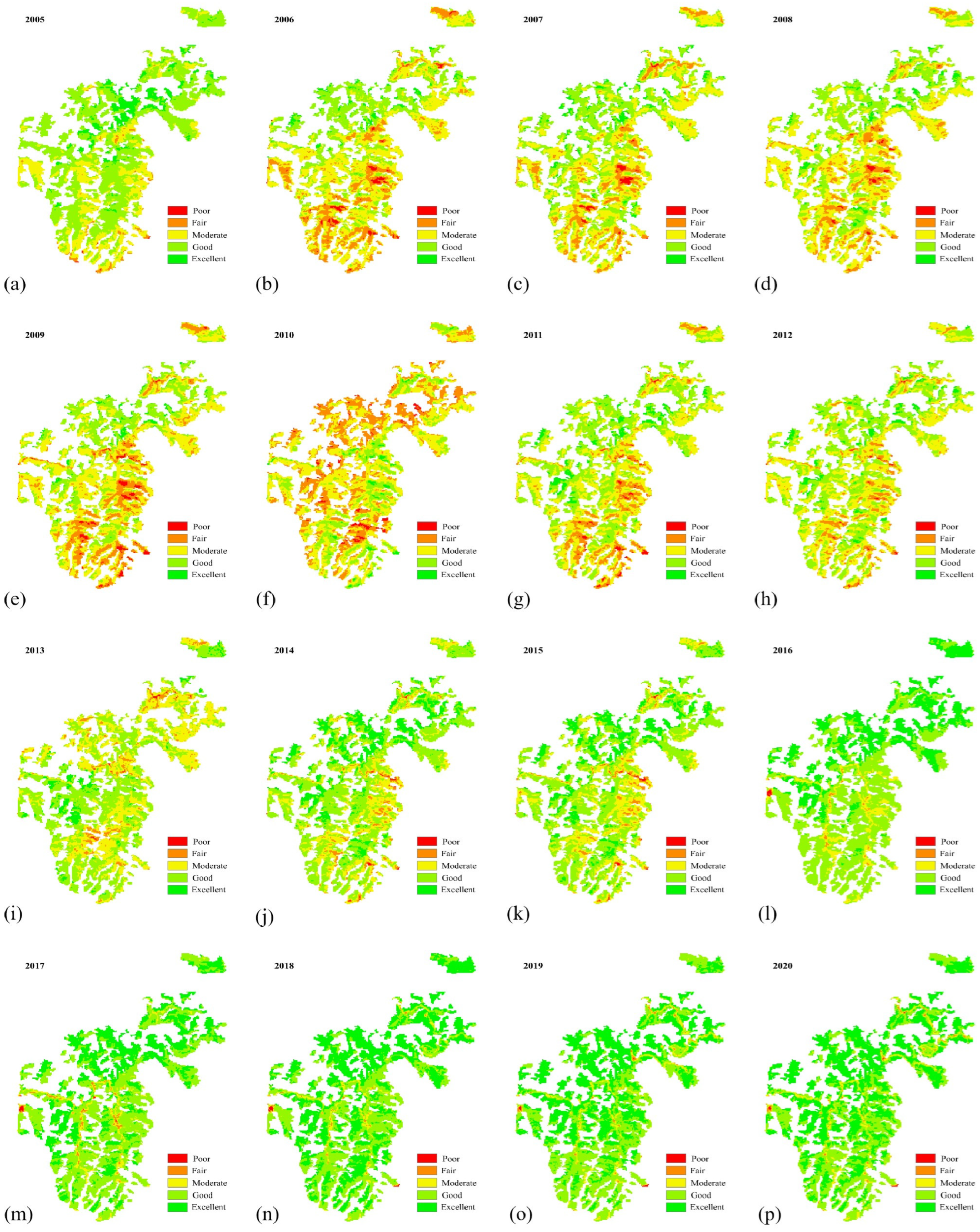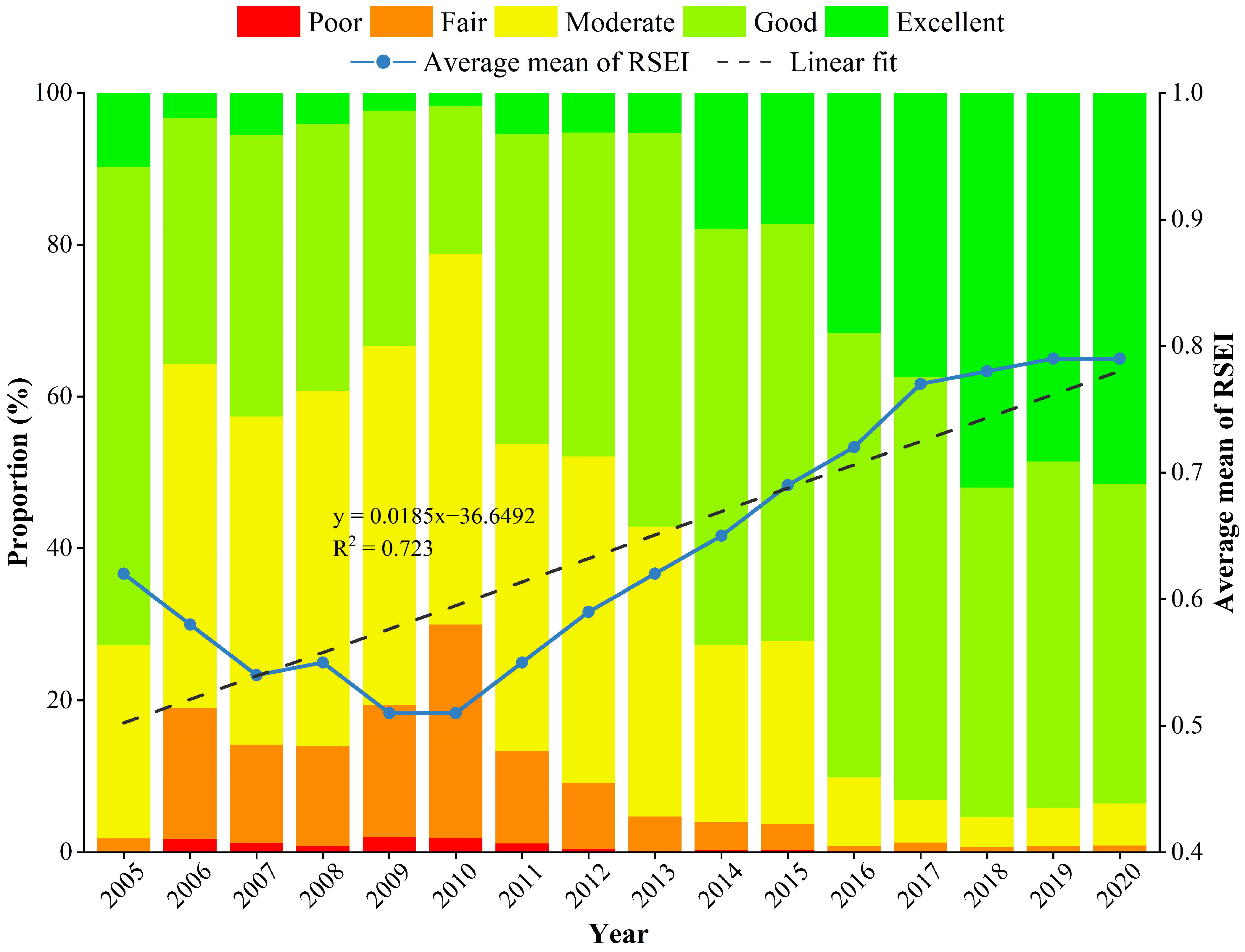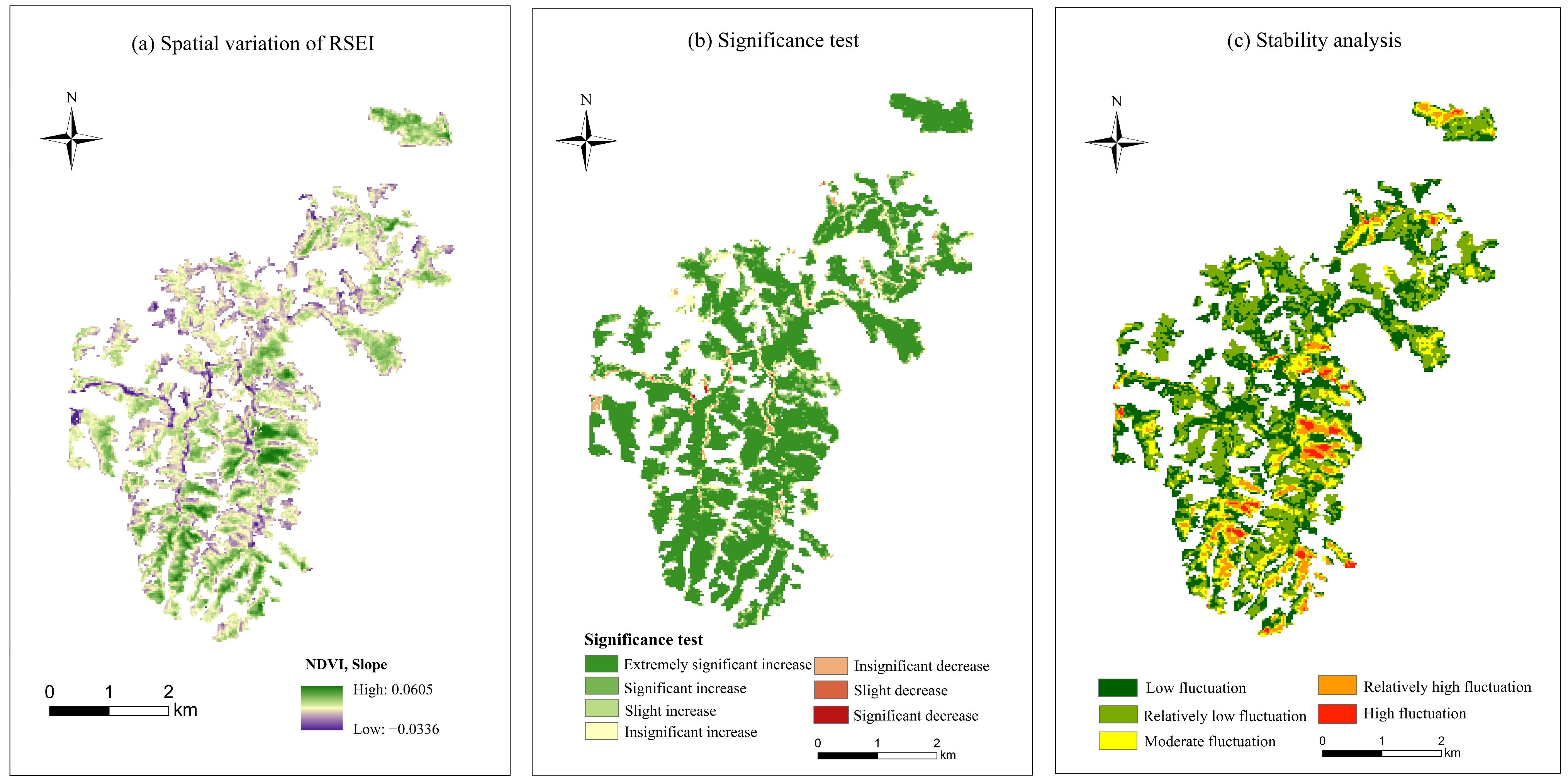Post-Fire Forest Ecological Quality Recovery Driven by Topographic Variation in Complex Plateau Regions: A 2006–2020 Landsat RSEI Time-Series Analysis
Abstract
1. Introduction
2. Materials and Methods
2.1. Study Area
2.2. Data Sources and Preprocessing
2.2.1. Landsat Imagery Data
2.2.2. Topographic Factor Data
2.2.3. Fire Point Data
2.3. Methods
2.3.1. Research Technical Workflow
2.3.2. Burned Area Extraction
2.3.3. RSEI Construction
2.3.4. Theil–Sen Estimator and MK Trend Test
2.3.5. Stability Analysis
2.3.6. Terrain Analysis
3. Results
3.1. Extraction of Burned Area Extent
3.2. Spatiotemporal Dynamics Analysis of RSEI
3.2.1. RSEI Feature Extraction Using PCA
3.2.2. Temporal and Spatial Analysis of RSEI
3.2.3. RSEI Trend Change Analysis
3.2.4. RSEI Stability Analysis
3.2.5. Terrain Effects on RSEI
4. Discussion
4.1. First Revealing the Temporal and Spatial Variation Patterns of Forest EQ Post-Fire in Complex Plateau Mountain Areas
4.2. RSEI Is Applicable for EQ Assessment at the Scale of Burned Areas in Complex Mountainous Plateaus
4.3. Post-Fire Forest EQ Recovery Exhibits Significant Topographic Effects
4.4. Uncertainty Analysis
5. Conclusions
Author Contributions
Funding
Data Availability Statement
Acknowledgments
Conflicts of Interest
Abbreviations
| EQ | Ecological quality |
| RSEI | Remote sensing ecological index |
| GEE | Google Earth Engine |
| NDVI | Normalized difference vegetation index |
| NBR | Normalized burn ratio |
| EVI | Enhanced vegetation index |
| NDMI | Normalized difference moisture index |
| NDWI | Normalized difference water index |
| mNDWI | Modified normalized difference water index |
| SAVI | Soil-adjusted vegetation index |
| BSI | Bare soil index |
| SNIC | Simple Non-Iterative Clustering |
| RF | Random forest |
| CV | Coefficient of variation |
| NDBSI | Normalized difference bare soil index |
| PCA | Principal component analysis |
| OA | Overall accuracy |
| UA | User accuracy |
| PA | Producer accuracy |
| MK | Mann–Kendall |
| PC1 | First principal component |
References
- Ballantyne, A.; Smith, W.; Anderegg, W.; Kauppi, P.; Sarmiento, J.; Tans, P.; Shevliakova, E.; Pan, Y.; Poulter, B.; Anav, A.; et al. Accelerating Net Terrestrial Carbon Uptake during the Warming Hiatus Due to Reduced Respiration. Nat. Clim. Change 2017, 7, 148–152. [Google Scholar] [CrossRef]
- Guo, F.; Su, Z.; Tigabu, M.; Yang, X.; Lin, F.; Liang, H.; Wang, G. Spatial Modelling of Fire Drivers in Urban-Forest Ecosystems in China. Forests 2017, 8, 180. [Google Scholar] [CrossRef]
- Loydi, A.; Funk, F.A.; García, A. Vegetation Recovery after Fire in Mountain Grasslands of Argentina. J. Mt. Sci. 2020, 17, 373–383. [Google Scholar] [CrossRef]
- Yang, X.; Meng, F.; Fu, P.; Zhang, Y.; Liu, Y. Spatiotemporal Change and Driving Factors of the Eco-Environment Quality in the Yangtze River Basin from 2001 to 2019. Ecol. Indic. 2021, 131, 108214. [Google Scholar] [CrossRef]
- Yuan, B.; Fu, L.; Zou, Y.; Zhang, S.; Chen, X.; Li, F.; Deng, Z.; Xie, Y. Spatiotemporal Change Detection of Ecological Quality and the Associated Affecting Factors in Dongting Lake Basin, Based on RSEI. J. Clean. Prod. 2021, 302, 126995. [Google Scholar] [CrossRef]
- An, M.; Xie, P.; He, W.; Wang, B.; Huang, J.; Khanal, R. Spatiotemporal Change of Ecologic Environment Quality and Human Interaction Factors in Three Gorges Ecologic Economic Corridor, Based on RSEI. Ecol. Indic. 2022, 141, 109090. [Google Scholar] [CrossRef]
- Hu, X.; Xu, H. A New Remote Sensing Index for Assessing the Spatial Heterogeneity in Urban Ecological Quality: A Case from Fuzhou City, China. Ecol. Indic. 2018, 89, 11–21. [Google Scholar] [CrossRef]
- Lv, Y.; Xiu, L.; Yao, X.; Yu, Z.; Huang, X. Spatiotemporal Evolution and Driving Factors Analysis of the Eco-Quality in the Lanxi Urban Agglomeration. Ecol. Indic. 2023, 156, 111114. [Google Scholar] [CrossRef]
- Miao, W.; Chen, Y.; Kou, W.; Lai, H.; Sazal, A.; Wang, J.; Li, Y.; Hu, J.; Wu, Y.; Zhao, T. The HANTS-Fitted RSEI Constructed in the Vegetation Growing Season Reveals the Spatiotemporal Patterns of Ecological Quality. Sci. Rep. 2024, 14, 14686. [Google Scholar] [CrossRef]
- Liu, C.; Yang, M.; Hou, Y.; Zhao, Y.; Xue, X. Spatiotemporal Evolution of Island Ecological Quality under Different Urban Densities: A Comparative Analysis of Xiamen and Kinmen Islands, Southeast China. Ecol. Indic. 2021, 124, 107438. [Google Scholar] [CrossRef]
- Wang, X.; Nian, Y.; Wang, H.; Chen, J.; Li, K.; Hu, T.; Li, Z. Monitoring of Ecological Environment Changes in Open-Pit Mines on the Loess Plateau from 1990 to 2023 Based on RSEI. Ecol. Indic. 2025, 170, 113064. [Google Scholar] [CrossRef]
- Qureshi, S.; Alavipanah, S.K.; Konyushkova, M.; Mijani, N.; Fathololomi, S.; Firozjaei, M.K.; Homaee, M.; Hamzeh, S.; Kakroodi, A.A. A Remotely Sensed Assessment of Surface Ecological Change over the Gomishan Wetland, Iran. Remote Sens. 2020, 12, 2989. [Google Scholar] [CrossRef]
- Crausbay, S.D.; Higuera, P.E.; Sprugel, D.G.; Brubaker, L.B. Fire Catalyzed Rapid Ecological Change in Lowland Coniferous Forests of the Pacific Northwest over the Past 14,000 Years. Ecology 2017, 98, 2356–2369. [Google Scholar] [CrossRef]
- Qiu, J.; Wang, H.; Shen, W.; Zhang, Y.; Su, H.; Li, M. Quantifying Forest Fire and Post-Fire Vegetation Recovery in the Daxin’anling Area of Northeastern China Using Landsat Time-Series Data and Machine Learning. Remote Sens. 2021, 13, 792. [Google Scholar] [CrossRef]
- Jiang, B.; Chen, W.; Wu, Y.; Gao, Z. Monitoring Vegetation Restoration after Wildfires in Typical Boreal Forests Based on Multi-Source Remote Sensing Data. In Proceedings of the Igarss 2024—2024 IEEE International Geoscience and Remote Sensing Symposium, Athens, Greece, 7–12 July 2024; pp. 581–584. [Google Scholar]
- Viana-Soto, A.; Aguado, I.; Martínez, S. Assessment of Post-Fire Vegetation Recovery Using Fire Severity and Geographical Data in the Mediterranean Region (Spain). Environments 2017, 4, 90. [Google Scholar] [CrossRef]
- Waring, R.H.; Coops, N.C.; Fan, W.; Nightingale, J.M. MODIS Enhanced Vegetation Index Predicts Tree Species Richness across Forested Ecoregions in the Contiguous U.S.A. Remote Sens. Environ. 2006, 103, 218–226. [Google Scholar] [CrossRef]
- Hanqiu, X. A Remote Sensing Urban Ecological Index and Its Application. Acta Ecol. Sin. 2014, 33, 7853–7862. [Google Scholar] [CrossRef]
- Zhang, S.; Bai, M.; Wang, X.; Peng, X.; Chen, A.; Peng, P. Remote Sensing Technology for Rapid Extraction of Burned Areas and Ecosystem Environmental Assessment. PeerJ 2023, 11, e14557. [Google Scholar] [CrossRef]
- Wang, R.; He, Y.; Li, S.; Huang, R. Forest Fire Monitoring Based on the Remote Sensing Technology. In Proceedings of the Fifth International Conference on Geology, Mapping, and Remote Sensing (ICGMRS 2024), Wuhan, China, 12–14 July 2024; p. 87. [Google Scholar]
- Xu, H.; Chen, J.; He, G.; Lin, Z.; Bai, Y.; Ren, M.; Zhang, H.; Yin, H.; Liu, F. Immediate Assessment of Forest Fire Using a Novel Vegetation Index and Machine Learning Based on Multi-Platform, High Temporal Resolution Remote Sensing Images. Int. J. Appl. Earth Obs. Geoinf. 2024, 134, 104210. [Google Scholar] [CrossRef]
- Yue, W.; Ren, C.; Liang, Y.; Liang, J.; Lin, X.; Yin, A.; Wei, Z. Assessment of Wildfire Susceptibility and Wildfire Threats to Ecological Environment and Urban Development Based on GIS and Multi-Source Data: A Case Study of Guilin, China. Remote Sens. 2023, 15, 2659. [Google Scholar] [CrossRef]
- Meng, R.; Dennison, P.E.; Huang, C.; Moritz, M.A.; D’Antonio, C. Effects of Fire Severity and Post-Fire Climate on Short-Term Vegetation Recovery of Mixed-Conifer and Red Fir Forests in the Sierra Nevada Mountains of California. Remote Sens. Environ. 2015, 171, 311–325. [Google Scholar] [CrossRef]
- Boucher, J.; Beaudoin, A.; Hébert, C.; Guindon, L.; Bauce, É. Assessing the Potential of the Differenced Normalized Burn Ratio (dNBR) for Estimating Burn Severity in Eastern Canadian Boreal Forests. Int. J. Wildland Fire 2017, 26, 32. [Google Scholar] [CrossRef]
- Giddey, B.L.; Baard, J.A.; Kraaij, T. Verification of the Differenced Normalised Burn Ratio (dNBR) as an Index of Fire Severity in Afrotemperate Forest. S. Afr. J. Bot. 2022, 146, 348–353. [Google Scholar] [CrossRef]
- Xu, H. A Remote Sensing Index for Assessment of Regional Ecological Changes. China Environ. Sci. 2013, 33, 889–897. [Google Scholar]
- Liu, P.; Ren, C.; Yu, W.; Ren, H.; Xia, C. Exploring the Ecological Quality and Its Drivers Based on Annual Remote Sensing Ecological Index and Multisource Data in Northeast China. Ecol. Indic. 2023, 154, 110589. [Google Scholar] [CrossRef]
- Tian, Y.; Wu, Z.; Li, M.; Wang, B.; Zhang, X. Forest Fire Spread Monitoring and Vegetation Dynamics Detection Based on Multi-Source Remote Sensing Images. Remote Sens. 2022, 14, 4431. [Google Scholar] [CrossRef]
- Giglio, L.; Schroeder, W.; Justice, C.O. The Collection 6 MODIS Active Fire Detection Algorithm and Fire Products. Remote Sens. Environ. 2016, 178, 31–41. [Google Scholar] [CrossRef]
- Campagnolo, M.L.; Libonati, R.; Rodrigues, J.A.; Pereira, J.M.C. A Comprehensive Characterization of MODIS Daily Burned Area Mapping Accuracy across Fire Sizes in Tropical Savannas. Remote Sens. Environ. 2021, 252, 112115. [Google Scholar] [CrossRef]
- Liu, X.; Meng, X.; Liu, Q.; Chen, X.; Zhao, R.; Shao, F. Multistage Progressive Interactive Fusion Network for Sentinel-2: High Resolution for All Bands. IEEE J. Sel. Top. Appl. Earth Obs. Remote Sens. 2023, 16, 10191–10202. [Google Scholar] [CrossRef]
- Alparone, L.; Garzelli, A.; Zoppetti, C. Fusion of VNIR Optical and C-Band Polarimetric SAR Satellite Data for Accurate Detection of Temporal Changes in Vegetated Areas. Remote Sens. 2023, 15, 638. [Google Scholar] [CrossRef]
- Wang, C.; Fan, Q.; Li, Q.; SooHoo, W.M.; Lu, L. Energy Crop Mapping with Enhanced TM/MODIS Time Series in the BCAP Agricultural Lands. ISPRS J. Photogramm. Remote Sens. 2017, 124, 133–143. [Google Scholar] [CrossRef]
- Wu, J.; Zhao, F.; Cook, B.D.; Hanavan, R.P.; Serbin, S.P. Measuring Short-Term Post-Fire Forest Recovery across a Burn Severity Gradient in a Mixed Pine-Oak Forest Using Multi-Sensor Remote Sensing Techniques. Remote Sens. Environ. 2018, 210, 282–296. [Google Scholar] [CrossRef]
- Hermosilla, T.; Wulder, M.A.; White, J.C.; Coops, N.C. Prevalence of Multiple Forest Disturbances and Impact on Vegetation Regrowth from Interannual Landsat Time Series (1985–2015). Remote Sens. Environ. 2019, 233, 111403. [Google Scholar] [CrossRef]
- Zheng, Z.; Wu, Z.; Chen, Y.; Guo, C.; Marinello, F. Instability of Remote Sensing Based Ecological Index (RSEI) and Its Improvement for Time Series Analysis. Sci. Total Environ. 2022, 814, 152595. [Google Scholar] [CrossRef]
- Zhang, Y.; Yi, L.; Xie, B.; Li, J.; Xiao, J.; Xie, J.; Liu, Z. Analysis of Ecological Quality Changes and Influencing Factors in Xiangjiang River Basin. Sci. Rep. 2023, 13, 4375. [Google Scholar] [CrossRef]
- Sen, P.K. Estimates of the Regression Coefficient Based on Kendall’s Tau. J. Am. Stat. Assoc. 1968, 63, 1379–1389. [Google Scholar] [CrossRef]
- Mann, H.B. Nonparametric Tests against Trend. Econometrica 1945, 13, 245. [Google Scholar] [CrossRef]
- Alharbi, S.; Raun, W.R.; Arnall, D.B.; Zhang, H. Prediction of Maize (Zea Mays L.) Population Using Normalized-Difference Vegetative Index (NDVI) and Coefficient of Variation (CV). J. Plant Nutr. 2019, 42, 673–679. [Google Scholar] [CrossRef]
- Liang, R.; Jue, C.; Tian, B.; Yang, Z. A Brief Analysis on Two Prediction Methods for Forest Fire in Anning City. For. Constr. 2021, 39, 20–25. [Google Scholar]
- Yan, X.; Wang, Q.; Li, C.; Li, X.; Li, S.; Han, Y. Combustibles in Fires of Major Forest Fires in Kunming. J. Southwest For. Univ. 2019, 39, 157–164. [Google Scholar] [CrossRef]
- Wulder, M.A.; Loveland, T.R.; Roy, D.P.; Crawford, C.J.; Masek, J.G.; Woodcock, C.E.; Allen, R.G.; Anderson, M.C.; Belward, A.S.; Cohen, W.B.; et al. Current Status of Landsat Program, Science, and Applications. Remote Sens. Environ. 2019, 225, 127–147. [Google Scholar] [CrossRef]
- White, J.C.; Wulder, M.A.; Hobart, G.W.; Luther, J.E.; Hermosilla, T.; Griffiths, P.; Coops, N.C.; Hall, R.J.; Hostert, P.; Dyk, A.; et al. Pixel-Based Image Compositing for Large-Area Dense Time Series Applications and Science. Can. J. Remote Sens. 2014, 40, 192–212. [Google Scholar] [CrossRef]
- Ye, J.; Wang, N.; Sun, M.; Liu, Q.; Ding, N.; Li, M. A New Method for the Rapid Determination of Fire Disturbance Events Using GEE and the VCT Algorithm—A Case Study in Southwestern and Northeastern China. Remote Sens. 2023, 15, 413. [Google Scholar] [CrossRef]
- Vujović, F.; Nikolić, G. Geospatial Assessment of Vegetation Condition Pre-Wildfire and Post-Wildfire on Luštica (Montenegro) Using Differenced Normalized Burn Ratio (dNBR) Index. Bull. Nat. Sci. Res. 2022, 12, 14–19. [Google Scholar] [CrossRef]
- Ambadkar, A.; Kathe, P.; Pande, C.B.; Diwate, P. Assessment of Spatial and Temporal Changes in Strength of Vegetation Using Normalized Difference Vegetation Index (NDVI) and Enhanced Vegetation Index (EVI): A Case Study from Akola District, Central India. In Geospatial Technology to Support Communities and Policy: Pathways to Resiliency; Geotechnologies and the Environment; Springer: Cham, Switzerland, 2024; Volume 26, pp. 289–304. ISBN 978-3-031-52560-5. [Google Scholar]
- Sivrikaya, F.; Günlü, A.; Küçük, Ö.; Ürker, O. Forest Fire Risk Mapping with Landsat 8 OLI Images: Evaluation of the Potential Use of Vegetation Indices. Ecol. Inform. 2024, 79, 102461. [Google Scholar] [CrossRef]
- Zhen, Z.; Chen, S.; Yin, T.; Chavanon, E.; Lauret, N.; Guilleux, J.; Henke, M.; Qin, W.; Cao, L.; Li, J.; et al. Using the Negative Soil Adjustment Factor of Soil Adjusted Vegetation Index (SAVI) to Resist Saturation Effects and Estimate Leaf Area Index (LAI) in Dense Vegetation Areas. Sensors 2021, 21, 2115. [Google Scholar] [CrossRef] [PubMed]
- Mzid, N.; Pignatti, S.; Huang, W.; Casa, R. An Analysis of Bare Soil Occurrence in Arable Croplands for Remote Sensing Topsoil Applications. Remote Sens. 2021, 13, 474. [Google Scholar] [CrossRef]
- Yang, G.; Yu, W.; Yao, X.; Zheng, H.; Cao, Q.; Zhu, Y.; Cao, W.; Cheng, T. AGTOC: A Novel Approach to Winter Wheat Mapping by Automatic Generation of Training Samples and One-Class Classification on Google Earth Engine. Int. J. Appl. Earth Obs. Geoinf. 2021, 102, 102446. [Google Scholar] [CrossRef]
- Li, M.; Yan, Y. Comparative Analysis of Machine-Learning Models for Soil Moisture Estimation Using High-Resolution Remote-Sensing Data. Land 2024, 13, 1331. [Google Scholar] [CrossRef]
- Solórzano, J.V.; Mas, J.F.; Gallardo-Cruz, J.A.; Gao, Y.; Fernández-Montes De Oca, A. Deforestation Detection Using a Spatio-Temporal Deep Learning Approach with Synthetic Aperture Radar and Multispectral Images. ISPRS J. Photogramm. Remote Sens. 2023, 199, 87–101. [Google Scholar] [CrossRef]
- Crist, E.P. A TM Tasseled Cap Equivalent Transformation for Reflectance Factor Data. Remote Sens. Environ. 1985, 17, 301–306. [Google Scholar] [CrossRef]
- Jimenez-Munoz, J.C.; Sobrino, J.A.; Skokovic, D.; Mattar, C.; Cristobal, J. Land Surface Temperature Retrieval Methods from Landsat-8 Thermal Infrared Sensor Data. IEEE Geosci. Remote Sens. Lett. 2014, 11, 1840–1843. [Google Scholar] [CrossRef]
- Parastatidis, D.; Mitraka, Z.; Chrysoulakis, N.; Abrams, M. Online Global Land Surface Temperature Estimation from Landsat. Remote Sens. 2017, 9, 1208. [Google Scholar] [CrossRef]
- Alexander, C. Normalised Difference Spectral Indices and Urban Land Cover as Indicators of Land Surface Temperature (LST). Int. J. Appl. Earth Obs. Geoinf. 2020, 86, 102013. [Google Scholar] [CrossRef]
- Xu, H. A Study on Information Extraction of Water Body with the Modified Normalized Difference Water Index (MNDWI). J. Remote Sens. 2005, 9, 589–595. [Google Scholar]
- DeVries, B.; Huang, C.; Armston, J.; Huang, W.; Jones, J.W.; Lang, M.W. Rapid and Robust Monitoring of Flood Events Using Sentinel-1 and Landsat Data on the Google Earth Engine. Remote Sens. Environ. 2020, 240, 111664. [Google Scholar] [CrossRef]
- Liu, Y.; Weng, Q. Impacts of 2D/3D Building Morphology on Vegetation Greening Trends in Hong Kong: An Urban-Rural Contrast Perspective. Urban For. Urban Green. 2025, 104, 128624. [Google Scholar] [CrossRef]
- Guo, M.; Li, J.; He, H.; Xu, J.; Jin, Y. Detecting Global Vegetation Changes Using Mann-Kendal (MK) Trend Test for 1982–2015 Time Period. Chin. Geogr. Sci. 2018, 28, 907–919. [Google Scholar] [CrossRef]
- Liu, Z.; Wang, H.; Li, N.; Zhu, J.; Pan, Z.; Qin, F. Spatial and Temporal Characteristics and Driving Forces of Vegetation Changes in the Huaihe River Basin from 2003 to 2018. Sustainability 2020, 12, 2198. [Google Scholar] [CrossRef]
- Kendall, M.G. Rank Correlation Methods. Biometrika 1957, 44, 298. [Google Scholar] [CrossRef]
- Chen, J.; Yang, S.; Li, H.; Zhang, B.; Lv, J.R. Research on Geographical Environment Unit Division Based on the Method of Natural Breaks (Jenks). Int. Arch. Photogramm. Remote Sens. Spat. Inf. Sci. 2013, XL-4/W3, 47–50. [Google Scholar] [CrossRef]
- GB/T 26424-2010; Technical Regulations for Inventory for Forest Management Planning and Design. Forest Resources: Beijing, China, 2011.
- Guz, J.; Sangermano, F.; Kulakowski, D. The Influence of Burn Severity on Post-Fire Spectral Recovery of Three Fires in the Southern Rocky Mountains. Remote Sens. 2022, 14, 1363. [Google Scholar] [CrossRef]
- Meng, Y.; Liu, X.; Ding, C.; Xu, B.; Zhou, G.; Zhu, L. Analysis of Ecological Resilience to Evaluate the Inherent Maintenance Capacity of a Forest Ecosystem Using a Dense Landsat Time Series. Ecol. Inform. 2020, 57, 101064. [Google Scholar] [CrossRef]
- Geng, J.; Yu, K.; Xie, Z.; Zhao, G.; Ai, J.; Yang, L.; Yang, H.; Liu, J. Analysis of Spatiotemporal Variation and Drivers of Ecological Quality in Fuzhou Based on RSEI. Remote Sens. 2022, 14, 4900. [Google Scholar] [CrossRef]
- Shafizadeh-Moghadam, H.; Khazaei, M.; Alavipanah, S.K.; Weng, Q. Google Earth Engine for Large-Scale Land Use and Land Cover Mapping: An Object-Based Classification Approach Using Spectral, Textural and Topographical Factors. GISci. Remote Sens. 2021, 58, 914–928. [Google Scholar] [CrossRef]
- Liu, S.; Zhang, B.; Yang, W.; Chen, T.; Zhang, H.; Lin, Y.; Tan, J.; Li, X.; Gao, Y.; Yao, S.; et al. Quantification of Physiological Parameters of Rice Varieties Based on Multi-Spectral Remote Sensing and Machine Learning Models. Remote Sens. 2023, 15, 453. [Google Scholar] [CrossRef]
- Dang, Y.; Yang, L.; Song, J. The Construction of a Crop Flood Damage Assessment Index to Rapidly Assess the Extent of Postdisaster Impact. Remote Sens. 2024, 16, 1527. [Google Scholar] [CrossRef]
- Breiman, L. Random Forests. Mach. Learn. 2001, 45, 5–32. [Google Scholar] [CrossRef]
- Chen, X.; Chen, W.; Xu, M. Remote-Sensing Monitoring of Postfire Vegetation Dynamics in the Greater Hinggan Mountain Range Based on Long Time-Series Data: Analysis of the Effects of Six Topographic and Climatic Factors. Remote Sens. 2022, 14, 2958. [Google Scholar] [CrossRef]
- Estes, B.L.; Knapp, E.E.; Skinner, C.N.; Miller, J.D.; Preisler, H.K. Factors Influencing Fire Severity under Moderate Burning Conditions in the Klamath Mountains, Northern California, USA. Ecosphere 2017, 8, e01794. [Google Scholar] [CrossRef]
- Birch, D.S.; Morgan, P.; Kolden, C.A.; Abatzoglou, J.T.; Dillon, G.K.; Hudak, A.T.; Smith, A.M.S. Vegetation, Topography and Daily Weather Influenced Burn Severity in Central Idaho and Western Montana Forests. Ecosphere 2015, 6, 1–23. [Google Scholar] [CrossRef]
- Zhang, L.; Xiao, J.; Li, J.; Wang, K.; Lei, L.; Guo, H. The 2010 Spring Drought Reduced Primary Productivity in Southwestern China. Environ. Res. Lett. 2012, 7, 45706. [Google Scholar] [CrossRef]
- Li, X.; Li, Y.; Chen, A.; Gao, M.; Slette, I.J.; Piao, S. The Impact of the 2009/2010 Drought on Vegetation Growth and Terrestrial Carbon Balance in Southwest China. Agric. For. Meteorol. 2019, 269–270, 239–248. [Google Scholar] [CrossRef]






| Landsat Series | Time | Path | GEE Dataset | Number |
|---|---|---|---|---|
| 5 TM | 2005–2011 | 129–043 | LANDSAT/LT05/C02/T1_L2 | 75 |
| 7 ETM+ | 2012 | 130–042 | LANDSAT/LE07/C02/T1_L2 | 20 |
| 8 OLI | 2013–2020 | 130–043 | LANDSAT/LC08/C02/T1_L2 | 171 |
| Indicators | Index | Formula | Explanation |
|---|---|---|---|
| Greenness | NDVI | represents the near-infrared band, while represents the red band [26]. | |
| Wetness | WET | represent the bands of Landsat 5, 7, and 8, respectively [26,54]. | |
| Heat | LST | The calculation of parameters refers to [55,56,57]. | |
| Dryness | NDBSI | SI represents the Soil Index, and IBI represents the Building Index [7,26]. | |
| / | mNDWI | and represent the green and shortwave infrared 1 bands, respectively [58]. |
| β | Z | Trend Features |
|---|---|---|
| β > 0 | 2.58 < Z | Extremely significant increase |
| 1.96 < Z ≤ 2.58 | Significant increase | |
| 1.65 < Z ≤ 1.96 | Slight increase | |
| Z ≤ 1.65 | Insignificant increase | |
| β = 0 | Z | Unchanged |
| β < 0 | Z ≤ 1.65 | Insignificant decrease |
| 1.65 < Z ≤ 1.96 | Slight decrease | |
| 1.96 < Z ≤ 2.58 | Significant decrease | |
| 2.58 < Z | Extremely significant decrease |
| Year | PC1 Eigenvector | Contribution Rate (%) | |||
|---|---|---|---|---|---|
| WET | NDVI | LST | NDBSI | ||
| 2005 | 0.26 | 0.49 | −0.47 | −0.69 | 67.51 |
| 2006 | 0.38 | 0.47 | −0.46 | −0.64 | 65.52 |
| 2007 | 0.38 | 0.48 | −0.49 | −0.61 | 66.61 |
| 2008 | 0.13 | 0.61 | −0.35 | −0.70 | 55.68 |
| 2009 | 0.31 | 0.50 | −0.52 | −0.62 | 63.17 |
| 2010 | 0.35 | 0.58 | −0.44 | −0.59 | 64.28 |
| 2011 | 0.27 | 0.53 | −0.53 | −0.60 | 60.88 |
| 2012 | 0.37 | 0.55 | −0.50 | −0.56 | 68.07 |
| 2013 | 0.33 | 0.48 | −0.55 | −0.60 | 64.66 |
| 2014 | 0.35 | 0.56 | −0.53 | −0.53 | 69.34 |
| 2015 | 0.29 | 0.52 | −0.51 | −0.63 | 66.55 |
| 2016 | 0.39 | 0.29 | −0.45 | −0.75 | 57.36 |
| 2017 | 0.47 | 0.39 | −0.60 | −0.52 | 63.36 |
| 2018 | 0.50 | 0.38 | −0.58 | −0.51 | 62.78 |
| 2019 | 0.53 | 0.42 | −0.62 | −0.41 | 63.79 |
| 2020 | 0.50 | 0.42 | −0.66 | −0.37 | 68.07 |
| Mean | 0.36 | 0.48 | −0.52 | −0.58 | 64.23 |
| Change Trend Type | Area (hm2) | Proportion (%) |
|---|---|---|
| Significant decrease | 1.12 | 0.07 |
| Slight decrease | 0.56 | 0.04 |
| Insignificant decrease | 25.53 | 1.69 |
| Insignificant increase | 150.14 | 9.92 |
| Slight increase | 59.99 | 3.96 |
| Significant increase | 215.79 | 14.26 |
| Extremely significant increase | 1060.14 | 70.06 |
| CV | Fluctuation Classes | Area (hm2) | Proportion (%) |
|---|---|---|---|
| <0.188 | Low | 543.46 | 35.91 |
| 0.188–0.241 | Relatively low | 629.63 | 41.61 |
| 0.241–0.323 | Moderate | 219.15 | 14.48 |
| 0.323–0.472 | Relatively high | 96.78 | 6.40 |
| >0.472 | High | 24.24 | 1.60 |
Disclaimer/Publisher’s Note: The statements, opinions and data contained in all publications are solely those of the individual author(s) and contributor(s) and not of MDPI and/or the editor(s). MDPI and/or the editor(s) disclaim responsibility for any injury to people or property resulting from any ideas, methods, instructions or products referred to in the content. |
© 2025 by the authors. Licensee MDPI, Basel, Switzerland. This article is an open access article distributed under the terms and conditions of the Creative Commons Attribution (CC BY) license (https://creativecommons.org/licenses/by/4.0/).
Share and Cite
Gao, J.; Chen, Y.; Xu, B.; Li, W.; Ye, J.; Kou, W.; Xu, W. Post-Fire Forest Ecological Quality Recovery Driven by Topographic Variation in Complex Plateau Regions: A 2006–2020 Landsat RSEI Time-Series Analysis. Forests 2025, 16, 502. https://doi.org/10.3390/f16030502
Gao J, Chen Y, Xu B, Li W, Ye J, Kou W, Xu W. Post-Fire Forest Ecological Quality Recovery Driven by Topographic Variation in Complex Plateau Regions: A 2006–2020 Landsat RSEI Time-Series Analysis. Forests. 2025; 16(3):502. https://doi.org/10.3390/f16030502
Chicago/Turabian StyleGao, Jiayue, Yue Chen, Bo Xu, Wei Li, Jiangxia Ye, Weili Kou, and Weiheng Xu. 2025. "Post-Fire Forest Ecological Quality Recovery Driven by Topographic Variation in Complex Plateau Regions: A 2006–2020 Landsat RSEI Time-Series Analysis" Forests 16, no. 3: 502. https://doi.org/10.3390/f16030502
APA StyleGao, J., Chen, Y., Xu, B., Li, W., Ye, J., Kou, W., & Xu, W. (2025). Post-Fire Forest Ecological Quality Recovery Driven by Topographic Variation in Complex Plateau Regions: A 2006–2020 Landsat RSEI Time-Series Analysis. Forests, 16(3), 502. https://doi.org/10.3390/f16030502








